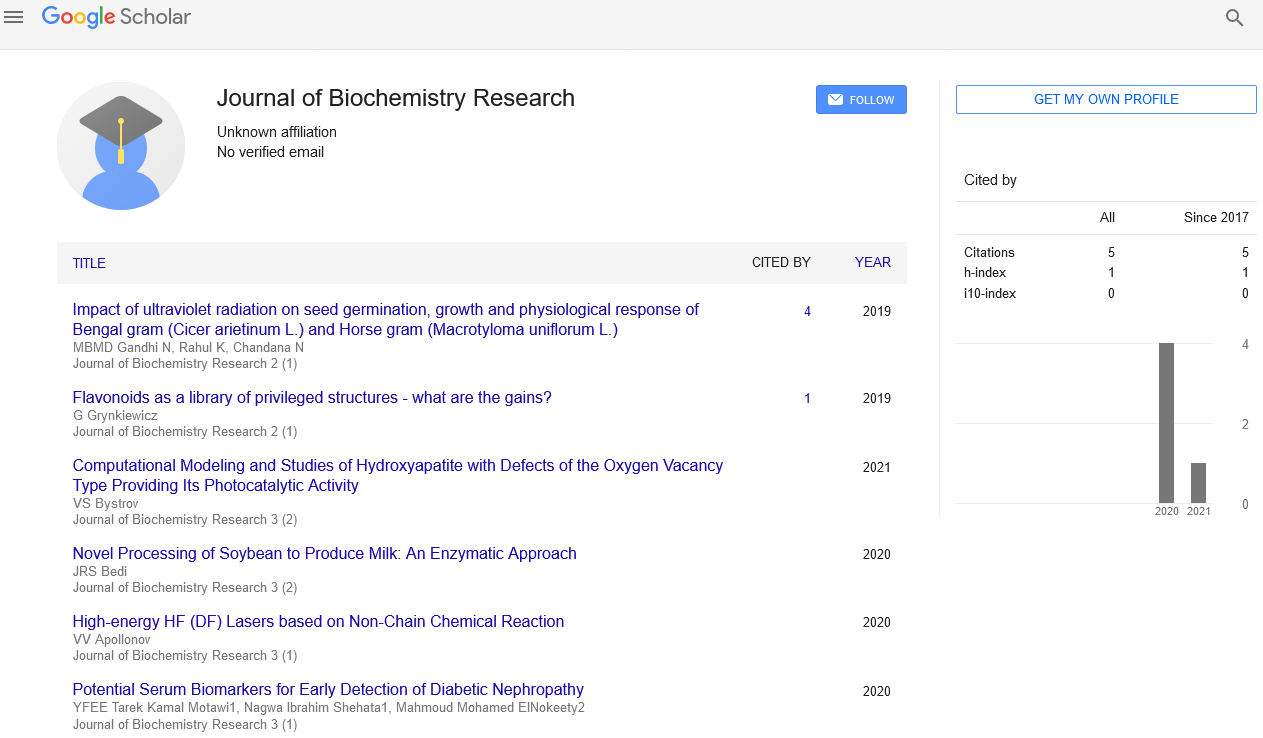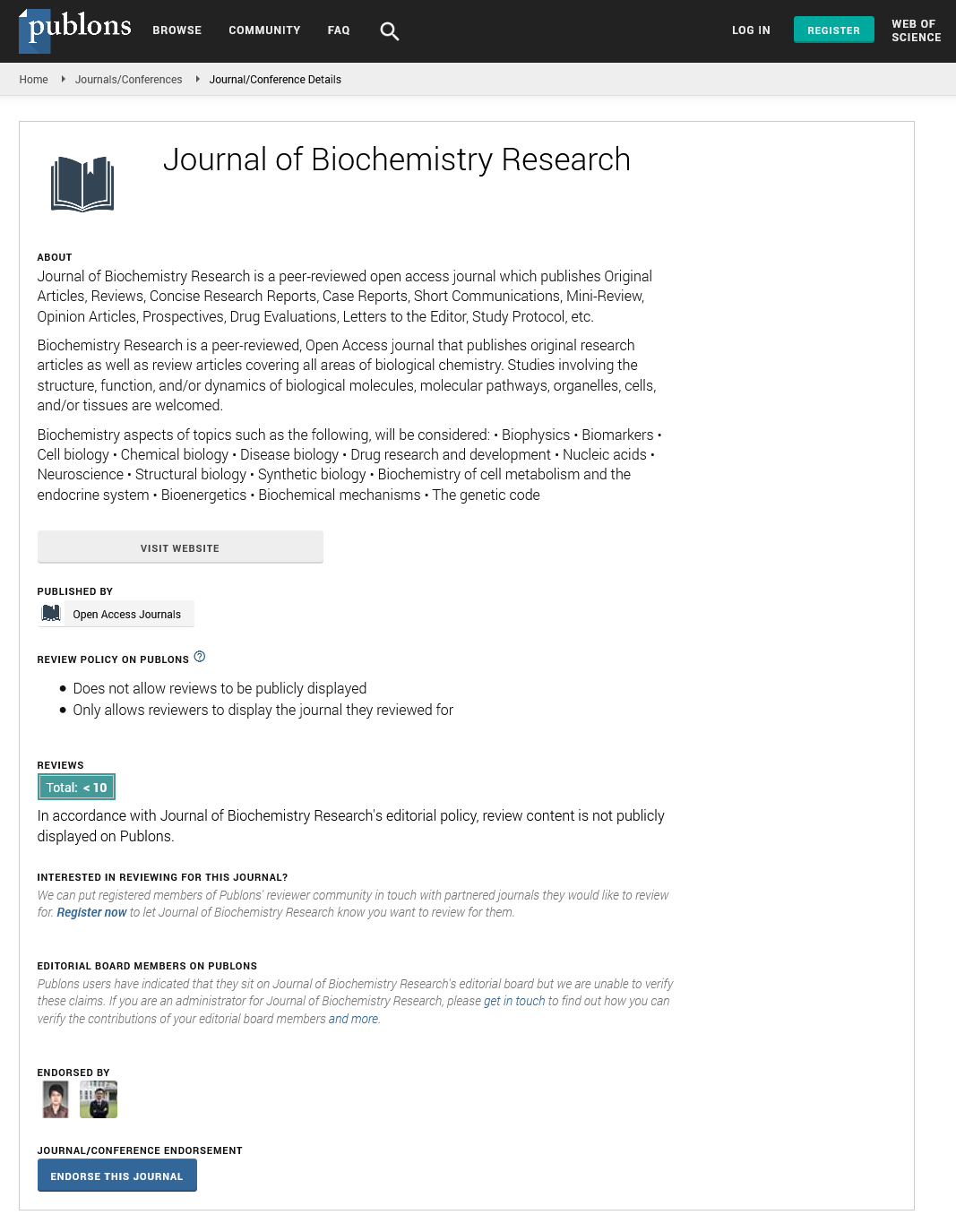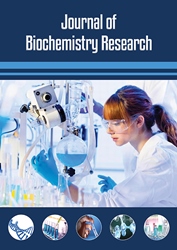Editorial - Journal of Biochemistry Research (2023) Volume 6, Issue 4
Unraveling Biochemical Mechanisms: Insights into the Molecular Basis of Biological Processes
Simran Kaur*
Department of Microbiology, University of Lucknow, India
Department of Microbiology, University of Lucknow, India
E-mail: SimranKaur43@gmail.com
Received: 1-August-2023, Manuscript No.oabr-23-109724; Editor assigned: 4- August-2023, Pre-QC No.oabr-23-109724 (PQ); Reviewed: 14-August-2023, QC No.oabr-23-109724; Revised: 22-August-2023, Manuscript No.oabr-23-109724 (R); Published: 31-August-2023 DOI: 10.37532/ oabr.2023.6(4).114-116
Abstract
The study of biochemical mechanisms represents a profound journey into the molecular underpinnings that govern the intricate processes of life. This article delves into the fascinating world of biochemical mechanisms, seeking to unravel the molecular basis of biological processes and shed light on the fundamental principles that drive cellular functions. Drawing from the realms of biochemistry, molecular biology, and biophysics, this exploration investigates the molecular interactions, pathways, and reactions that orchestrate the diverse array of biological processes. From the enzymatic catalysis that drives essential biochemical reactions to the intricate regulation of gene expression, the molecular intricacies governing life’s processes come to the forefront. Specific emphasis is placed on understanding the structural and functional aspects of biomolecules, such as proteins, nucleic acids, lipids, and carbohydrates. By elucidating the three-dimensional architectures and dynamic properties of these molecules, we gain insights into how they carry out their vital roles in cellular physiology and metabolism. The exploration of biochemical mechanisms extends to signaling networks that enable communication and coordination within and between cells. Investigating the molecular mechanisms that underlie cellular responses to environmental cues provides a deeper understanding of how organisms sense and adapt to their surroundings. Furthermore, this article highlights the significance of unraveling biochemical mechanisms in the context of human health and disease. The molecular basis of various disorders is explored, shedding light on the dysregulation of biochemical pathways and offering potential targets for therapeutic intervention.
Keywords
Biochemical mechanisms • Molecular basis • Biological processes • Enzymatic catalysis
Introduction
At the heart of life’s complexity lies a captivating world of biochemical mechanisms that govern the intricate processes of living organisms. Unraveling these mechanisms offers profound insights into the molecular basis of biological processes, providing a window into the fundamental principles that drive cellular functions [1]. From enzymatic reactions that sustain metabolism to the regulation of gene expression that shapes cellular identity, the study of biochemical mechanisms unveils the molecular choreography that orchestrates life’s diverse functions [2]. In this exploration, we embark on a fascinating journey into the realm of biochemical mechanisms, seeking to decipher the molecular intricacies that underlie the wonders of life [3]. Drawing from the disciplines of biochemistry, molecular biology, and biophysics, we delve into the world of molecular interactions, pathways, and reactions that constitute the machinery of life [4]. The exploration encompasses a diverse array of biomolecules, including proteins, nucleic acids, lipids, and carbohydrates, whose structural and functional features lie at the core of cellular processes [5]. Understanding the three-dimensional architectures and dynamic properties of these biomolecules enables us to grasp how they carry out their vital roles in cellular physiology and metabolism [6]. Enzymes, the catalysts of life, drive essential biochemical reactions, while nucleic acids encode the blueprints of life’s diversity and evolution [7]. Lipids and carbohydrates serve as structural elements and energy reservoirs, further enriching the molecular symphony of life [8]. The exploration of biochemical mechanisms also extends to signaling networks that enable communication and coordination within and between cells. Investigating the molecular basis of cellular responses to environmental cues unveils the intricate pathways that allow organisms to sense and adapt to their surroundings [9]. The dynamic interactions within these signaling networks reveal the versatility and adaptability of life’s molecular machinery. Moreover, the significance of unraveling biochemical mechanisms reaches beyond the realm of basic science [10]. The molecular basis of various diseases comes into focus, shedding light on the dysregulation of biochemical pathways that underlie pathogenesis [11]. This knowledge opens new avenues for therapeutic intervention, where targeted approaches can address the molecular roots of diseases, leading to more effective treatments and improved patient outcomes [12].
Discussion
Enzymatic Catalysis: Participants can delve into the significance of enzymatic catalysis in driving essential biochemical reactions. The discussion can explore how enzymes facilitate the conversion of substrates into products and the factors that influence enzyme activity and specificity. Structural and Functional Features of Biomolecules: The exploration can focus on specific biomolecules, such as proteins, nucleic acids, lipids, and carbohydrates, and their structural and functional roles in cellular processes. Participants can discuss the diversity of functions these molecules perform and how their interactions contribute to the complexity of life. Gene Expression and Regulation: The discussion can extend to the regulation of gene expression, a fundamental process that controls cellular identity and function. Participants can explore the intricate molecular mechanisms of transcription, translation, and epigenetic regulation that govern gene expression. Dynamic Properties of Biomolecules: The dynamic nature of biomolecules and their conformational changes in response to cellular signals can be discussed. Participants can explore how these dynamic properties underlie the adaptability of cells and their ability to respond to changing environmental conditions. Cellular Signaling Pathways: The exploration can encompass the molecular basis of cellular signaling pathways, including receptor-ligand interactions, second messenger systems, and signal transduction cascades. Participants can discuss how these pathways relay information within cells and coordinate cellular responses. Metabolic Pathways: Participants can explore the interconnected metabolic pathways that regulate energy production, biosynthesis, and degradation of biomolecules. The discussion can emphasize the role of key enzymes and regulatory checkpoints in metabolic control. Role in Human Health and Disease: The implications of understanding biochemical mechanisms in the context of human health and disease can be highlighted. Participants can discuss how dysregulation of these mechanisms contributes to various disorders and how this knowledge informs therapeutic strategies. Biotechnological Applications: The practical applications of unraveling biochemical mechanisms in biotechnology can be explored. Participants can discuss how this knowledge is harnessed for the development of novel biotechnological processes, such as enzyme engineering and metabolic engineering. Agricultural Importance: The discussion can extend to the significance of biochemical mechanisms in agriculture, where understanding plant and microbial biochemistry is essential for crop improvement and sustainable agriculture. Challenges and Future Directions: Participants can address current challenges in studying biochemical mechanisms, such as the complexity of cellular processes and the need for advanced experimental techniques. The discussion can also explore future research directions and the potential for interdisciplinary collaborations to advance our understanding of life’s molecular intricacies.
Conclusion
Understanding the structural and functional features of biomolecules, from proteins to nucleic acids and lipids, has revealed the remarkable versatility and diversity of functions they perform within cells. The dynamic properties of these biomolecules enable cells to adapt, respond to environmental cues, and maintain cellular homeostasis. The exploration of gene expression and regulation has shed light on how cells control their identity and function, shaping the complexity and specialization of different cell types. Cellular signaling pathways have unveiled the language of cellular communication, facilitating the coordination and integration of diverse cellular processes. The significance of unraveling biochemical mechanisms reaches far beyond the realms of scientific inquiry. By understanding the molecular basis of diseases, we have opened new avenues for therapeutic interventions and personalized medicine, where targeted approaches hold the promise of more effective treatments and improved patient outcomes. Furthermore, the practical applications of this knowledge extend to biotechnology and agriculture, where harnessing biochemical mechanisms enable the development of novel processes and sustainable solutions. As we conclude this exploration, we are reminded of the profound interconnectedness between biochemical mechanisms and the intricate web of life they govern. This understanding empowers us to navigate the complexities of health and disease with unprecedented precision, propelling scientific advancements and transforming healthcare practices. The quest to unravel the mysteries of life’s molecular intricacies is a journey that holds great promise for the future of scientific discovery and human wellbeing. As we continue to explore the frontiers of biochemical mechanisms, we embrace the limitless possibilities that lie ahead. With each new revelation, we come closer to deciphering the secrets of life and harnessing the wonders of biochemical mechanisms for the betterment of humanity and the world we inhabit. As we strive to unlock the molecular basis of biological processes, we embark on a transformative journey that will shape the future of scientific knowledge and elevate the quality of life for generations to come.
References
- Abt MC, Artis D. The intestinal microbiota in health and disease the influence of microbial products on immune cell homeostasis. Curr Opin Gastroenterol. 25, 496-502 (2009).
- Schaffert CS, Duryee MJ, Hunter CD et al. Alcohol metabolites and lipopolysaccharide roles in the development and/or progression of alcoholic liver disease. World J Gastroenterol. 15, 1209-1218 (2009).
- Wiest R, Rath HC. Bacterial translocation in the gut. Best Pract Res Clin Gastroenterol. 17: 397-425 (2003).
- Garcia-Tsao G, Lee FAY, Barden GE et al. Bacterial translocation to mesenteric lymph nodes is increased in cirrhotic rats with ascites. Gastroenterology. 108, 1835-1841 (1995).
- Such J, Francés R, Muoz C et al. Detection and identification of bacterial DNA in patients with cirrhosis and culture-negative, nonneutrocytic ascites. Hepatology. 36, 135-141 (2002).
- Shindo K, Machida M, Miyakawa K et al. A syndrome of cirrhosis, achlorhydria, small intestinal bacterial overgrowth, and fat malabsorption. Am J Gastroenterol Suppl. 88, 2084-2091 (1993).
- Liu MT, Rothstein JD, Gershon MD et al. Glutamatergic enteric neurons. J Neurosci Res. 17:4764-4784 (1997).
- Shehadi WH. The biliary system through the ages. Int Surg J. 64: 63-78 (1979).
- Stroffolini T, Sagnelli E, Mele A et al. HCV infection is a risk factor for gallstone disease in liver cirrhosis an Italian epidemiological survey. J Viral Hepat. 14, 618-623 (2007).
- Bouchier IA. Postmortem study of the frequency of gallstones in patients with cirrhosis of the liver. Gut. 10, 705-710.
- Conte D, Fraquelli M, Fornari F et al. Close relation between cirrhosis and gallstones: cross-sectional and longitudinal survey. Arch Intern Med. 159, 49-52 (1999).
- Maggi A, Solenghi D, Panzeri A et al. Prevalence and incidence of cholelithiasis in patients with liver cirrhosis. Gastroenterol Hepatol. 29, 330-335 (1997).
Google Scholar, Crossref, Indexed at
Google Scholar, Crossref, Indexed at
Google Scholar, Crossref, Indexed at
Google Scholar, Crossref, Indexed at
Google Scholar, Crossref, Indexed at
Google Scholar, Crossref, Indexed at
Google Scholar, Crossref, Indexed at
Google Scholar, Crossref, Indexed at
Google Scholar, Crossref, Indexed at


